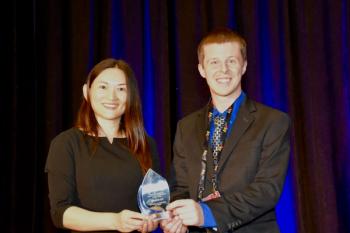
Wavelength Tech Forum: General Trends
This month's Technology Forum looks at the topic of general industry trends and the issues surrounding them. Joining us for this discussion are Kevin McLaughlin, with Shimadzu Scientific Instruments, Vanaja Sivakumar, with SPEX CertiPrep, Inc., and Eric Schmidt, with Ahura Scientific, Inc.
This month’s Technology Forum looks at the topic of general industry trends and the issues surrounding them. Joining us for this discussion are Kevin McLaughlin, with Shimadzu Scientific Instruments, Vanaja Sivakumar, with SPEX CertiPrep, Inc., and Eric Schmidt, with Ahura Scientific, Inc.
What has been the most important development in the spectroscopy field over the past few years?
(McLaughlin) Automation of spectroscopic instrumentation, along with compatibility of different analytical instruments with spectroscopic instruments, is one of the most important developments in the field. Introducing automation to the spectroscopic field through sampling, auto samplers, data analysis and integration has not only provided users with time to perform other duties, but, more importantly, has improved the quality of the results through improving the reproducibility and accuracy of the data and eliminating any errors generated by the user. Research is venturing into different arenas and is calling for usage of different instrumentation, and sometimes coupling of that instrumentation, to obtain better results and reduce the work needed in pretreatment or preparation of the samples.
(Sivakumar) Some of the most important developments in the last few years are solid state generators, collision cell technology, and DRC technology that reduced/eliminated interference problems.
(Schmidt) One of the most important developments we've seen is the ability to design spectroscopic solutions to address a critical market need. General purpose instruments will always have their place, but recent advancements in hardware, optics and embedded analysis have opened the possibility of making spectroscopic devices fit the need and user like a glove fits a hand.We see the emergence of application-specific spectrometers, optimized to perform particular tasks for specific groups of users; from recycling to homeland security. To be successful in this emerging market-space requires a radically new approach, a new way of thinking about how and where spectroscopy can have the most impact and development of products that address the particular needs of a specific user. Portability, accuracy and user interface all need to be designed in parallel to enable handheld instrumentation that will be readily adopted.
What are some mistakes and setbacks you've seen in the spectroscopy field over the past few years?
(McLaughlin) In science there are no setbacks or mistakes to my understanding, as every trial, whether it fails or not, is an initial step for another trial which may eventually end up in a recognized success.
(Sivakumar) One major setback in the last few years is low cost, poor quality AA. Also, ICP and ICP/MS software have become complex and full potential of the instrument is not realized if the operators are poorly trained.
(Schmidt) Historically, spectroscopy has taken place in the laboratory using general-purpose equipment, designed for use by highly trained spectroscopists and requiring a tremendous amount of maintenance, calibration and general upkeep. These expensive and general-purpose machines can be thought of as the “mainframes” of laboratory instruments. While not necessarily a setback, this limited the impact spectroscopy could have on broader markets. Spectroscopy is an extremely powerful technology, and yet until recently, the vast majority of lay people haven’t been able to harness that power.
How has spectroscopy software improved over the past few years?
(McLaughlin) Spectral and chemical interference in the spectroscopy field has been a greater challenge to scientists over the years. Changes were made to the instruments and analysis process, but most of the burden was placed on the user to figure out what interferences might be avoided to obtain accurate results. Recently, the software used with spectroscopic instrumentation relieved the user from such a burden by introducing a Method Development module, which helps the user develop the best conditions to eliminate any interference; and a Method Diagnosis module, which helps the user by examining the data and identifying the interferences and suggesting the best conditions for improving the accuracy of the results.
(Sivakumar) Spectroscopy software has had tremendous improvements resulting in more control over instrument function and automated optimization of instruments.
(Schmidt) Software is always evolving but traditional instrumentation companies have focused their development efforts more on the instruments themselves. Traditional lab system software is certainly more feature-rich than it was 10 years ago, including some improved automation for routine tasks, but adding more buttons to the toolbar and options to the menus doesn’t necessarily mean more power for the users. For companies who are developing application-specific spectroscopic devices the real challenge is to design interfaces that are intuitive for nontechnical end-users, and software that can make expert decisions.
What do you believe the future holds for handheld/portable instrumentation in the spectroscopy field?
(McLaughlin) Handheld/portable instrumentation is always a plus for flexibility in terms of remote area analysis (out of the laboratory). In regard to spectroscopic analysis, mobilization of the instruments is considered a plus, but this is relative to the technique and instrument being used, as movement might affect the hardware and analysis of the instrument, which may then require realignment and recalibration. The use of handheld and portable instruments is limited to specific fields, as by using them you are accepting results with limited accuracy. As for laboratory spectroscopic instrumentation, if alternative methods for realignment and recalibration are found to counteract the effect of moving these instruments, then the handheld/portable capability becomes a plus.
(Sivakumar) Field screening will become popular if more accurate measurements can be made from smaller portable instruments.
(Schmidt) With continual advances in computing power and microelectronics, we can certainly expect instrumentation to become even smaller and faster over time, while increasing speed and functionality. We also expect an increased focus on interconnectivity as instruments are designed with improved networking capabilities.Smaller and less expensive technology will lead to “personal spectrometers” optimized for a particular user and his/her style of use. Custom menus, shortcuts, methods, hot-keys are all possible to personalize the user/machine process. For these markets to take off, users must be able to obtain actionable answers, rather than raw data that require further analysis and interpretation. These spectroscopic instruments must be extremely easy to use â as easy as a cell phone with menu driven navigation. This requires new software designed from the ground up, not just a portable version of existing programs.
What new developments in spectroscopy would you like to see over the next few years?
(McLaughlin) Asking any scientist or user that question would generate an endless list of wishes, but I would say continued progress toward full automation of the instruments, more intelligent software, and instruments that can be moved more easily without the extra work required to counteract the effect of the move and without jeopardizing the data.
(Sivakumar) We need smaller footprints of instruments. We also need more user-friendly software for different levelsâ for routine or mass production, for higher professional level, software that would enable service (simple) by operators as well as by trained service professionals.
(Schmidt) We’d all like spectroscopy help address the most urgent needs of society; terrorism, disease, environment, and energy. With the advent of a personalized instrument, users will be able to develop innovative field-enabled applications for spectroscopic techniques. We see greater integration of spectroscopic technologies, providing a more comprehensive solution for users.
What do you think?
Newsletter
Get essential updates on the latest spectroscopy technologies, regulatory standards, and best practices—subscribe today to Spectroscopy.




